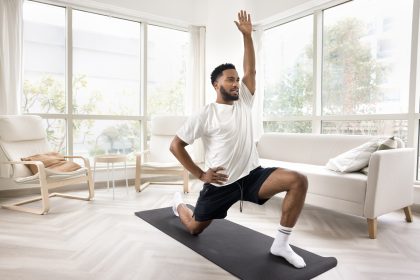The simple act of walking backwards, though rarely practiced in daily life, might offer unexpectedly powerful benefits for brain health. This unconventional movement pattern challenges the brain in unique ways that forward walking cannot, potentially enhancing neural connections and cognitive function. Recent investigations into this overlooked exercise approach reveal promising implications for maintaining and potentially improving brain health throughout life.
How backward motion creates novel neural challenges for the brain
Walking backward fundamentally disrupts the brain’s deeply ingrained movement patterns. From early childhood, humans develop neural pathways optimized for forward locomotion—our visual system faces forward, our balance mechanisms calibrate accordingly, and our motor planning focuses on navigating the path ahead. When we reverse this direction, these established systems must rapidly recalibrate and develop new coordination strategies.
This recalibration process engages multiple brain regions simultaneously. The cerebellum, responsible for coordinating movement and balance, works overtime during backward walking to maintain stability without visual feedback from the path ahead. The motor cortex must generate movement patterns that feel unnatural and require conscious attention rather than automatic execution. Meanwhile, spatial awareness centers in the parietal cortex reconfigure environmental mapping to accommodate the reversed perspective.
The proprioceptive system—the body’s internal awareness of position and movement—becomes particularly activated during backward walking. Without visual cues guiding movement, the brain relies heavily on proprioceptive feedback from joints, muscles, and tendons to navigate safely. This heightened proprioceptive engagement stimulates neural pathways that often remain underutilized during routine forward movement.
Perhaps most significantly, backward walking demands substantial cognitive involvement compared to forward walking. The prefrontal cortex, crucial for executive function, planning, and problem-solving, activates significantly during backward movement as the brain consciously plans each step. This enhanced prefrontal activation represents a form of cognitive exercise embedded within physical movement, potentially offering dual benefits for brain health.
The remarkable memory and cognitive improvements
Cognitive neuroscientists studying backward walking have documented intriguing improvements in memory function following regular practice. One particularly notable study tracked older adults who incorporated ten minutes of backward walking three times weekly over three months. Participants demonstrated measurable improvements in both working memory and episodic memory compared to control groups who maintained their usual physical activities.
Working memory—the system allowing temporary information retention and manipulation—appears especially responsive to backward walking practice. Tasks requiring participants to hold and process information simultaneously showed performance improvements correlating with backward walking frequency. This enhancement suggests the cognitive demands of backward locomotion may strengthen neural networks supporting working memory function.
Spatial memory also shows enhancement through backward walking practice. Navigating environments in reverse requires creating comprehensive mental maps rather than relying on forward-facing visual cues. This spatial processing challenge strengthens hippocampal function—the brain region central to spatial navigation and memory formation. Brain imaging studies confirm increased hippocampal activity during and after backward walking sessions compared to forward walking.
Attention and focus capabilities demonstrate improvement with regular backward walking practice. The heightened concentration required to move safely backward appears to strengthen attentional networks, creating benefits that transfer to other cognitive tasks. Participants in backward walking studies consistently show enhanced performance on sustained attention assessments following regular practice periods.
The cognitive benefits extend to certain executive functions including cognitive flexibility and inhibitory control. Moving backward requires inhibiting the strongly ingrained forward movement patterns while flexibly adapting to an unusual locomotion style. This mental flexibility potentially transfers to other situations requiring adaptive thinking and resistance to automatic responses—important cognitive skills that often decline with age.
Neural plasticity mechanisms behind backward walking benefits
The brain’s remarkable capacity for structural and functional change—neuroplasticity—provides the foundation for backward walking benefits. This unconventional movement creates the precise conditions needed to stimulate neuroplastic adaptations: novel challenge, focused attention, and repeated practice. These elements combine to strengthen existing neural connections while potentially forming new pathways.
Backward walking generates increased production of brain-derived neurotrophic factor (BDNF), a protein crucial for neural growth and protection. This growth factor stimulates the development of new neural connections while supporting the survival of existing neurons. The cognitive challenge of backward movement appears to trigger more substantial BDNF release than equivalent forward exercise, potentially explaining its enhanced brain benefits.
White matter integrity—the structural connections between brain regions—shows improvement following consistent backward walking practice. Diffusion tensor imaging reveals enhanced white matter structure in pathways connecting motor planning regions with spatial processing centers. These structural improvements facilitate more efficient communication between brain regions crucial for coordinated movement and cognitive function.
The cerebellum undergoes particularly notable adaptation with backward walking practice. This brain region, traditionally associated primarily with movement coordination, increasingly shows important roles in cognitive processing. The cerebellar stimulation provided by backward movement potentially offers benefits extending beyond motor control to higher cognitive functions including timing, sequencing, and even certain language processes.
Functional connectivity between brain regions strengthens through backward walking practice. Network analyses of brain activity reveal enhanced coordination between motor areas, spatial processing centers, and prefrontal regions during complex cognitive tasks following backward walking interventions. This improved neural coordination may underlie the observed cognitive enhancements and suggest mechanisms for maintaining brain health with age.
Balance improvements and fall prevention considerations
Beyond direct cognitive benefits, backward walking significantly enhances balance and coordination—functions closely intertwined with brain health. The vestibular system, responsible for detecting head position and maintaining equilibrium, receives intensive training during backward walking. This stimulation strengthens connections between vestibular structures and the cerebellum, potentially improving overall balance control.
The balance improvements from backward walking appear particularly valuable for older adults, who face increased fall risk with age. Studies demonstrate that incorporating backward walking into exercise routines substantially reduces fall incidence compared to forward walking alone. This protective effect likely stems from enhanced proprioception, stronger stabilizing muscles, and improved rapid balance recovery capabilities.
Gait parameters including stride length, step symmetry, and movement efficiency show measurable improvement following backward walking training. These enhancements transfer partially to forward walking, suggesting backward practice creates broader movement control benefits. The neural adaptations underlying these improvements reflect strengthened connections between motor planning centers and movement execution pathways.
Fall prevention represents a significant health concern for aging populations, with falls often triggering serious health declines. The balance improvements from backward walking directly address this risk factor through multiple mechanisms: enhanced lower body strength, improved reactivity to unexpected balance challenges, and better overall proprioceptive awareness. These physical benefits complement the cognitive enhancements, potentially offering comprehensive brain and body protection.
Practical implementation strategies for backward walking practice
Incorporating backward walking safely requires thoughtful implementation strategies. Beginning in controlled environments minimizes risk while allowing adaptation to the unusual movement pattern. A clear, flat indoor space with supporting structures nearby offers an ideal starting point for those new to backward walking. As comfort increases, practice can gradually shift to varied environments with appropriate safety precautions.
Visual strategies help overcome the unique challenges of not seeing the path ahead. Beginning practice with occasional backward glances helps develop spatial awareness while maintaining safety. As skill increases, reliance on visual checking typically decreases as proprioceptive awareness improves. Some practitioners find partner guidance valuable during initial sessions, with verbal cues about approaching obstacles or direction changes.
Duration and frequency considerations influence effectiveness without creating excessive fatigue or injury risk. Starting with brief sessions—perhaps two to three minutes—allows adaptation while preventing overexertion. As comfort increases, gradually extending to ten-minute sessions three times weekly appears sufficient for cognitive benefits while remaining manageable for most individuals.
Surface variations offer progressive challenges as basic backward walking becomes comfortable. Transitioning from flat indoor surfaces to varied outdoor terrain introduces additional proprioceptive challenges that further stimulate neural adaptation. This progression should occur gradually with appropriate support mechanisms to ensure safety throughout the learning process.
For those with existing mobility or balance concerns, modified approaches maintain safety while still providing neural benefits. Parallel bars, walking poles, or physical therapy supervision offer additional support for vulnerable individuals. Even very slow, limited backward movement with appropriate assistance still challenges the brain in beneficial ways, suggesting adaptations can accommodate various physical capabilities.
Comparing backward walking with other brain health interventions
Backward walking occupies an interesting position among brain health interventions, offering both physical and cognitive stimulation simultaneously. Traditional cognitive training programs typically involve seated activities focused solely on mental challenge, while conventional exercise emphasizes physical movement without specific cognitive engagement. Backward walking bridges this divide by embedding cognitive challenge within physical activity.
Compared to computerized brain training programs, backward walking shows comparable or superior benefits for certain cognitive domains while additionally providing cardiovascular and musculoskeletal advantages. The combined physical-cognitive nature of backward walking potentially creates synergistic effects exceeding what either approach achieves independently. This integration may explain the substantial cognitive improvements observed even with relatively brief backward walking sessions.
Dance, another movement form requiring coordination and learning, shares some mechanisms with backward walking. Both activities challenge established movement patterns while requiring spatial awareness and motor planning. However, backward walking offers accessibility advantages, requiring no special skills, music, or instruction to begin practice. This simplicity makes backward walking particularly suitable for widespread implementation across diverse populations.
Meditation and mindfulness practices share backward walking’s emphasis on present-moment awareness and focused attention. The concentrated attention required for safe backward movement creates a naturally mindful state as practitioners must remain fully engaged with current sensations and surroundings. This attentional quality potentially contributes to the cognitive benefits while offering an alternative for those who find seated meditation challenging.
The neuroplasticity mechanisms underlying backward walking benefits appear similar to those activated by learning new skills like musical instruments or languages. All these activities create novel neural challenges requiring sustained practice and attention. However, backward walking requires minimal equipment, instruction, or prior knowledge, potentially offering a more accessible entry point to neuroplastic stimulation for many individuals.
The exploration of backward walking for brain health reveals fascinating connections between movement patterns and cognitive function. This simple reversal of habitual locomotion creates cascade effects throughout neural systems, potentially offering an accessible, effective approach to maintaining cognitive vitality with age. As research continues examining optimal implementation strategies and long-term outcomes, backward walking provides an intriguing addition to comprehensive brain health approaches combining physical activity with cognitive challenge.
















